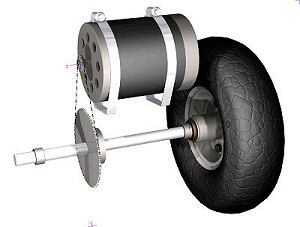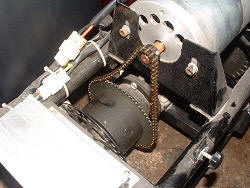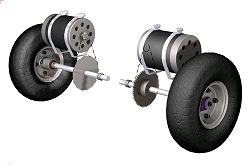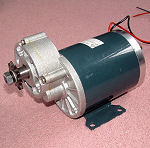Page 1
Page 2
Page 3
The different ways in which electric drive motors can be
connected to vehicle drive wheels is an area of interest for many DIY
kart and buggy builders.
Over the years I've tried a number of
approaches and here are a few suggestions -
Starting with
the simplest.
1. Fit the
Wheel directly on the Motor Shaft
..... don't! This won't work unless you are using a "hub
motor" - ie a type of low speed, high torque electric motor that is
specifically designed to carry a drive wheel. Generally these are quite
expensive, and the more commonly available drive motors run too fast and
with too low a torque for a direct drive to the wheels. You will
probably need at least a single stage speed reduction.....
2. Single Stage Speed Reduction Stage
Most of the drive motors I use come fitted with a small
roller chain sprocket on the output shaft ready for assembly with a
chain transmission. Single stage reductions can also be implemented with
toothed belt transmissions or geared transmissions.
The
image shows a single stage roller chain drive to a rotating drive axle.
The wheel is fixed to the axle and the axle is bearing mounted (either
directly housed or by pillow block) on the vehicle chassis. This type of
arrangement works with vehicles with relatively fast turning wheels as
the size of the speed reduction that can be achieved is effectively limited by the
size of larger chain sprocket.
Extending the axle to carry the second rear drive wheel
provides a simple dual wheel drive, however one with no effective
differential action for cornering. To introduce good differential
behaviour use either an electric motor for each wheel (below left) or
fit a differential gear box (below right - single stage reduction drive
on a commercial kart).


 The
single stage arrangement can be used for slower speed wheel drives if
used in conjunction with a drive motor with a built-in gear box (see
image left). These transmissions are effectively double or triple stage
reductions with the "gearhead" on the motor providing the first
reduction stages. The outcome is a lower speed / higher torque drive to
the wheels better suited to lower speed vehicles with smaller wheels or
for higher speed vehicles with larger wheels - in both low wheel rpm and
high drive torque is needed.
The
single stage arrangement can be used for slower speed wheel drives if
used in conjunction with a drive motor with a built-in gear box (see
image left). These transmissions are effectively double or triple stage
reductions with the "gearhead" on the motor providing the first
reduction stages. The outcome is a lower speed / higher torque drive to
the wheels better suited to lower speed vehicles with smaller wheels or
for higher speed vehicles with larger wheels - in both low wheel rpm and
high drive torque is needed.
The type of gearing in the
motor will affect it's behaviour - be careful with worm geared units if
you need regenerative braking.
....... go to Page 2 - Double Stage Reduction Drives